- Home
- Encyclopedia
- The Burlington Route: Wyoming’s Second Transcon...
The Burlington Route: Wyoming’s Second Transcontinental Railroad
The Union Pacific railroad propelled the economy of southern Wyoming during the territorial era. But after statehood in 1890 the Chicago, Burlington and Quincy Railroad (CB&Q) started to drive development into the northern half of the state. Such Wyoming towns as Newcastle, Sheridan, Gillette, Cody, Powell, Worland and Thermopolis all owe their growth to the arrival of the CB&Q.
The Chicago, Burlington and Quincy had two reasons for investing in Wyoming. First, the company wanted Wyoming’s timber, coal and iron to sell in eastern markets, and also for operating its large network stretching from Denver, Colo. back to Chicago, Ill. More importantly, railroad officials saw that northern Wyoming lay at the crossroads of the northern Rockies. Wyoming offered the best routes for transcontinental lines originating in the Midwest and South and terminating in the Pacific Northwest.
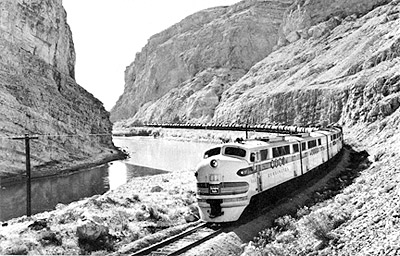
This strategic combination of mineral resources and geography brought rail development to northern Wyoming beginning in the 1890s. The same factors remained important to the CB&Q throughout the 20th century, even as the company went through several consolidations to become the Burlington Northern Santa Fe.
The CB&Q operated under several names in Wyoming. It financed construction in the state through entities like the Grand Island and Northern Wyoming Railroad Company and the Big Horn Railroad Company. After construction ended, the CB&Q bought these paper companies and incorporated them into its network. Wyoming residents rarely used the names of the construction companies. Instead they referred to the new lines as the Burlington and Missouri Railroad, the B&M or simply “The Burlington,” a nickname that signified the CB&Q’s financial control over all of these lines.
The Chicago, Burlington and Quincy’s entrance into Wyoming in the 1880s evolved out of decades of expansion across the Midwest and the Great Plains under the direction of Boston capitalist John Murray Forbes.
John Forbes’ wealth originally came from his family’s trading operations with China. He first worked for his uncle’s accounting house in Boston, Mass. at age 15. Two years later, the family sent Forbes to Canton, China to be their agent, replacing his older brother who had suddenly died. He became an expert negotiator with the Chinese, returning to Boston as a wealthy man in 1837 when he was only 24 years old.
Starting in 1846, Forbes pooled his fortune with investors from Massachusetts and New York to start building railroads. By the 1850s, his group operated several roads including the CB&Q line, which stretched between its namesake towns of Chicago, Ill., Burlington, Iowa and Quincy, Ill. The company later pushed west from Burlington to Council Bluffs, Iowa, and developed a southern route from St. Louis to Kansas City, Mo.
In 1869, the CB&Q established a new subsidiary, the Burlington and Missouri Rail Road Company in Nebraska, or B&MRR, which continued building west and reached Denver in 1882.
In 1881 John Forbes’ second cousin Charles Perkins was elected president of the CB&Q. Over the next 20 years, Perkins proved himself a master of corporate strategy who kept the company from overextending itself. Each year, he traveled thousands of miles over the company’s lines to oversee operations. It was Perkins’ vision for the Burlington expansion that made Wyoming a crossroads between the Mississippi River heartland and Puget Sound in the Pacific Northwest.
In 1886, a westward extension through Elwood, Neb. brought the Burlington’s first entrance into southeast Wyoming and subsequent arrival at Cheyenne in December 1887. But the competing Union Pacific Railroad occupied the route through southern Wyoming to Utah, stalling any thoughts for the B&M to expand farther west toward Salt Lake City.
Also in 1886, the Wyoming Central Railway opened a line parallel to the Union Pacific but about 110 miles farther north, through Lusk, Wyo. to Douglas, Wyo., taking that area out of play for a B&M route. By 1888, the Wyoming Central extended the line along the Platte River to Glenrock and Casper. (This line was leased and operated by the Fremont, Elkhorn & Missouri Valley Railroad until its purchase in 1903 by the Chicago and North Western Railroad.) The country to the north of the Wyoming Central remained undeveloped — and full of coal, according to Burlington surveyors.
On June 13, 1889, Charles Perkins called for the Burlington to begin work on a new line northwest from Alliance, Neb., to the Black Hills of South Dakota and into Wyoming. The CB&Q financed the Grand Island and Northern Wyoming Railroad Company to manage construction of the project. The new line would aim for a connection with the Northern Pacific Railroad that had been built across southern Montana in 1883.
Perkins believed he could make an agreement that would allow Burlington trains to run over Northern Pacific lines going to the West. This would provide the Burlington with its desired connection to Puget Sound without the expense of building all the way to the coast. If the Northern Pacific would not agree to the proposal, Perkins intended to continue building west toward the rich mining regions of western Montana.
Construction proceeded slowly over a period of five years under the direction of Kilpatrick Brothers and Collins Contractors of Beatrice, Neb. Locomotives hauled supplies to the end of the line where horse-drawn graders built the right of ways. Workers used machinery to set rails, but they placed the innumerable ties and spikes by hand.
Starting from Alliance in November of 1888, the Burlington rail crews reached the Black Hills in October 1889 and arrived in Newcastle, Wyo. on Nov. 18. By Dec. 1, 1889 the workers completed a seven-mile branch line north to the coal mines at Cambria. Both towns were named for mining towns in the British Isles. (Over the next few years the company also built spur lines to Deadwood, Hot Springs, and Spearfish, S.D.)
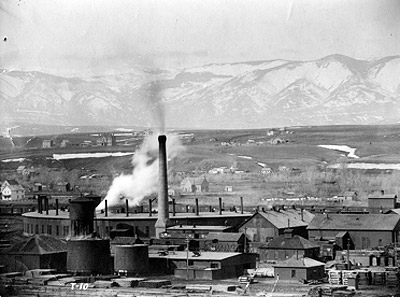
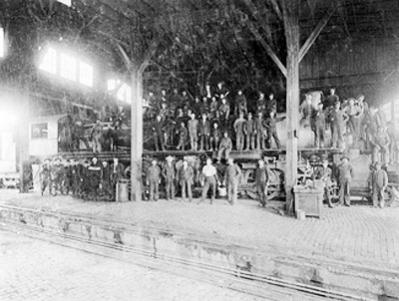
In the spring of 1890 the Burlington continued on from Newcastle and completed the section west to Merino, Wyo. (now Upton) by Aug. 5. Having spent nearly $3 million on lines from the Black Hills out to Merino, the company fell short of cash and suspended work until the next year.
By August of 1891, the rails reached Donkey Town, Wyo., the company having taken a shortcut discovered by an astute surveyor and Yale graduate named Edward Gillette. The new route eliminated unnecessary bridges across Donkey Creek. Gillette hoped for a bonus for his efforts. Instead, the company scrapped the name of Donkey Town and re-named the town for him. Despite the honor, he later lived in Sheridan where he married the daughter of U.S. Congressman H.A. Coffeen.
In 1892, the rails crossed Powder River at Suggs (present-day Arvada, Wyo.), and then headed up Clear Creek toward the Big Horn Mountains. The Burlington rails reached Sheridan, Wyo. on Nov. 22, and the first train arrived four days later, bringing new life to the 10-year-old cow town. The demands of railroad construction and its workers created an economic boom with increased sales of local produce, livestock and merchandise. Many Sheridan residents paid off their bank loans.
Over the next decade, the railroad prompted development of Sheridan County’s coal mines, along with large-scale tie-cutting operations that harvested timber in the mountains and transported the logs down a flume through Tongue River Canyon.
The Burlington opened bids for construction of a spur to Buffalo, Wyo., but the Johnson County War of 1892 caused an atmosphere of uncertainty that made the company abandon the plans. Later, the citizens of Buffalo built their own spur line called the Wyoming Railway and known to locals as The Duffy.
In May of 1893, Perkins secured his deal with the Northern Pacific to allow Burlington trains to run on the Northern Pacific lines west from Billings, Mont. This effectively bridged the two companies’ networks and created a new transcontinental route. The Burlington invested $2 million to build the line from Sheridan north into Montana toward this junction with the Northern Pacific.
Construction north from Sheridan began in June of 1893, but stalled when the nation’s economy crashed later that year. In contrast to other railroads, Charles Perkins’ wise leadership of the B&M kept the company from overreaching. His financial caution allowed track work to resume in April 1894, and the railroad reached Montana and the Crow Reservation in August. Construction then proceeded rapidly down the Little Big Horn Valley, west to Toluca, Mont. finally reaching Huntley, Mont., on the Yellowstone River on Oct. 28. From there, CB&Q trains used the Northern Pacific tracks to make the final 13 miles west to Billings.
The Burlington did not resume construction in Wyoming until 1900, when it built an extension from Northport, Neb., to Guernsey, Wyo. This new line offered access to farms along the North Platte River and to the rich iron mines at Hartville and Sunrise, Wyo.
Work also began on a 131-mile spur from Toluca, Mont. west of Hardin, Mont. to Cody, Wyo. That route opened on Nov. 11, 1901, providing access to Yellowstone Park and the burgeoning irrigation projects of the Big Horn Basin.
That same year, Perkins completed the sale of the CB&Q to the Northern Pacific and Great Northern, which jointly purchased the CB&Q and its subsidiaries in order to expand their networks east from Minneapolis, Minn. This would ensure a better balance of trade between westbound cotton and freight shipments and eastbound timber. The CB&Q and Burlington names remained in use on their traditional routes, including the roads in Wyoming.
Between 1902 and 1905, this new conglomerate with the tycoon James J. Hill at the helm started developing plans to connect the Pacific Northwest and the Gulf of Mexico with a line from the Big Horn Basin to the North Platte River. The Big Horn Railroad Company was set up as a paper corporation for the work. Construction began at Frannie, Wyo., on Oct. 3, 1905, and moved south along the Big Horn River through Greybull, Basin, and Worland, Wyo. to reach Kirby, Wyo. on Sept. 3, 1907. Work halted there until 1909.
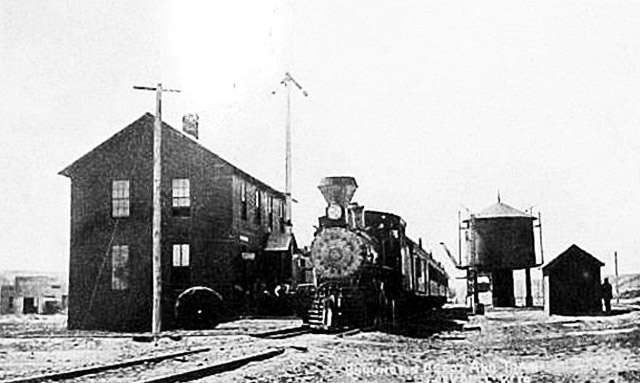
During this period, the CB&Q operated an Immigration Bureau to lure settlers to take up land in the Big Horn Basin’s new irrigation projects. More settlers would mean more rail traffic, and more revenue for the railroad. Between 1906 and 1913, railroad officials reported that their publicity brought an estimated 8,000 families to the Basin. Deaver, Wyo., is named for D. Clem Deaver, head of the Burlington Immigration Bureau. The company also donated funds to the University of Wyoming’s experimental farms at Casper and Newcastle to promote dry farming practices suited to the state’s semi-arid climate.
In 1908, James Hill of the Northern Pacific, Great Northern and CB&Q purchased the Colorado and Southern Railroad and the Fort Worth and Denver Railroad. This gave him a line from Texas though Denver to Cheyenne, Wyo., which he intended to connect with Seattle, Wash. in order to balance freight between the Pacific Northwest and the Gulf of Mexico. With this big picture in mind, he moved to complete the Burlington line between Kirby and the North Platte River.
The selected route would run south from Kirby through Wind River Canyon, and then turn east over a broad divide into the North Platte watershed. In 1909, construction took the line from Kirby to Thermopolis, Wyo. The blasting of tunnels through granite walls on the west side of Wind River Canyon slowed construction for several years. The line finally reached Casper on Oct. 20, 1913.
The CB&Q finally connected with the Colorado and Southern lines at Orin Junction, Wyo., on the North Platte River east of Casper in 1914, creating the shortest route from the Gulf to the Pacific via rail. However, the opening of the Panama Canal that same year caused most shipping to bypass this rail route.
Major construction on the CB&Q in Wyoming ceased on Dec. 15, 1915, when a new cutoff between Guernsey and nearby Wendover, Wyo. offered a better link with the Colorado and Southern lines.
In addition to its role transporting goods and passengers, the Burlington provided plenty of steady jobs. Sheridan, Wyo., had a large switchyard, a roundhouse and a tie-treatment plant that operated from 1904 to 1957. The Burlington also drew tourists to Wyoming by advertising guest ranches located along the route, particularly those in the mountains near Sheridan and Cody.
The CB&Q pioneered the use of diesel-electric engines in 1937, leading, ironically, to the decline of some of the same coal towns the line helped create. Even with the development of streamlined Zephyr locomotives and sleek passenger trains, the Burlington and other railroads saw a nationwide drop in passenger use throughout the 1930s.
During World War II, troop transport brought a flood of military-related travel and CB&Q traffic increased dramatically. The Burlington salvaged 30,000 tons of steel for the war effort by consolidating 87 miles of its line west of Casper with the Chicago and Northwestern.
After the war, travelers increasingly chose highway and air transport over trains. The Burlington closed passenger service between Denver, Colo., and Billings, Mont. in October 1967. The last scheduled passenger train from Alliance, Neb., through Sheridan to Billings, Mont. ran on Aug. 24, 1969. Thereafter coal trains kept the Burlington active in Wyoming.
In 1970, the Burlington Northern Railroad was created through merger of the CB&Q; the Great Northern; the Northern Pacific; the Spokane, Portland & Seattle Railroad and the Pacific Coast Railway. The increased strength of this company inspired additional investment.
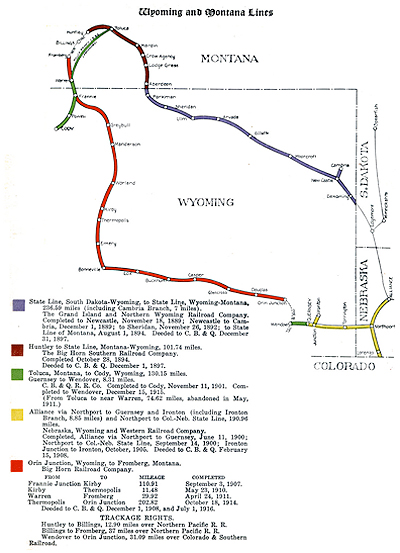
As huge strip mines for low-sulfur coal developed in Wyoming’s Powder River Basin, the BN started building grades for a route called the Orin Cutoff. This new line would run south from mines near Gillette through the hamlet of Bill, Wyo. to Orin Junction on the North Platte River.
Construction was delayed until 1976 when the Interstate Commerce Commission granted approval for the BN to build the line jointly with the Chicago & North Western Railroad. The C&NW later dropped out due to lack of funds.
The BN finally began laying track north from Orin Junction on May 1, 1979, and south from Gillette on July 15, 1979. The rails joined 11 miles south of Bill, Wyo., on Oct. 6, 1979, and opened to traffic one month later.
The new route spanned 113 lonely miles of Wyoming at a cost of $110 million. This made it the longest railroad line built anywhere in the nation since 1931. The C&NW later bought into the Orin Cutoff, but passed its usage rights to the Union Pacific after a merger.
In 1995, the BN merged with the Atchison, Topeka and Santa Fe to form the Burlington Northern Santa Fe. The line continues to serve agriculture in the Big Horn Basin, but most of its Wyoming business is coal. Trains stretching a mile long run day and night out of the Powder River Basin via the Orin Cutoff, bound for power plants in the Midwest, South and East that each burn about a trainload of Wyomng coal per day.
Traces of the original CB&Q are still evident across the state in existing rights of way, old depots and a collection of rail cars at the Railroad Interpretive Center in Douglas. While the Burlington lines no longer wield an economic power that eclipses all other forces of development, the BNSF still plays a vital role in the economy of northern Wyoming communities.
Resources
Primary Sources
- Gillette, Edward. Locating the Iron Trail. (Boston: The Christopher Publishing House, 1925), 76-77.
Secondary Sources
- Baldwin, William Wright. Corporate History of the Chicago, Burlington & Quincy Railroad Company: pursuant to Interstate Commerce Commission valuation order no. 20, under act of Congress approved March 1, 1913. (Chicago: Chicago, Burlington, and Quincy Railroad Company, 1921), 370.
- Burlington Northern Santa Fe. “The History of BNSF: A Legacy for the 21st Century.” Railway: The Employee Magazine of the Burlington Northern Santa Fe Corporation, 1999, 3-8.
- Kistler, Richard C., and Joseph C. Hardy. Alliance and Everywhere West. (David City, Nebraska: South Platte Press, 1990), 15, 73, 141-143.
- Larson, T. A. History of Wyoming. (Lincoln: University of Nebraska Press, 1965), 160, 298, 339, 340, 483.
- McPhee, John. Uncommon Carriers. (New York: Farrar, Straus and Giroux, 2007), 185-237.
- Olinger, Ralph. “Frank Lusk: Early Livestock Man, Railroader.” Costlow Collection, Niobrara County Library. Accessed November 21, 2010. http://www.niobraracountylibrary.org/history/index.php?id=15
- Overton, Richard C. Burlington Route: A History of the Burlington Lines. (New York: Alfred A. Knopf, 1965), 27-28, 60-61, 186, 197-198, 227-229, 233, 269, 274-276, 281-282, 284-285, 409, 506.
- Wagner, F. Hol, Jr. Burlington Northern 1977-80 Annual. (Denver: Motive Power Services, 1981), 71.
For Further Reading
- Ferguson, John B.“Reminiscences of an Early-Day Railroad Civil Engineer in Northwestern Wyoming.” Annals of Wyoming. 13:1 (January 1941), 48-57.
- Nielsen, Margaret E. “Roving over the Wilds of Wyoming.” Annals of Wyoming. 53:1 (Spring, 1981), 49-53.
Illustrations
- The photo of the train in Sheep River Canyon north of Greybull is a CB&Q publicity photo, courtesy of Burlington Route Historical Society Archives, Burlington Route Historical Society Archives. Special thanks to Jim Brown of Basin, Wyo. for helping us correctly locate the site of the photo.
- The photo of the Burlington railyard in Sheridan is courtesy of Wyoming Room Sheridan County Fulmer Public Library.
- The photo of the Burlington locomotive shop and crew is courtesy of Sheridan County Museum.
- The 1909 photo of the Burlington locomotive in Greybull is courtesy of, Wyoming Tales and Trails, with thanks.
- The map of the Burlington Route is courtesy of the Burlington Route Historical Society.
- The photo of the CB&Q locomotive at the Douglas Railroad Interpretive Center is courtesy of the Douglas Chamber of Commerce.
